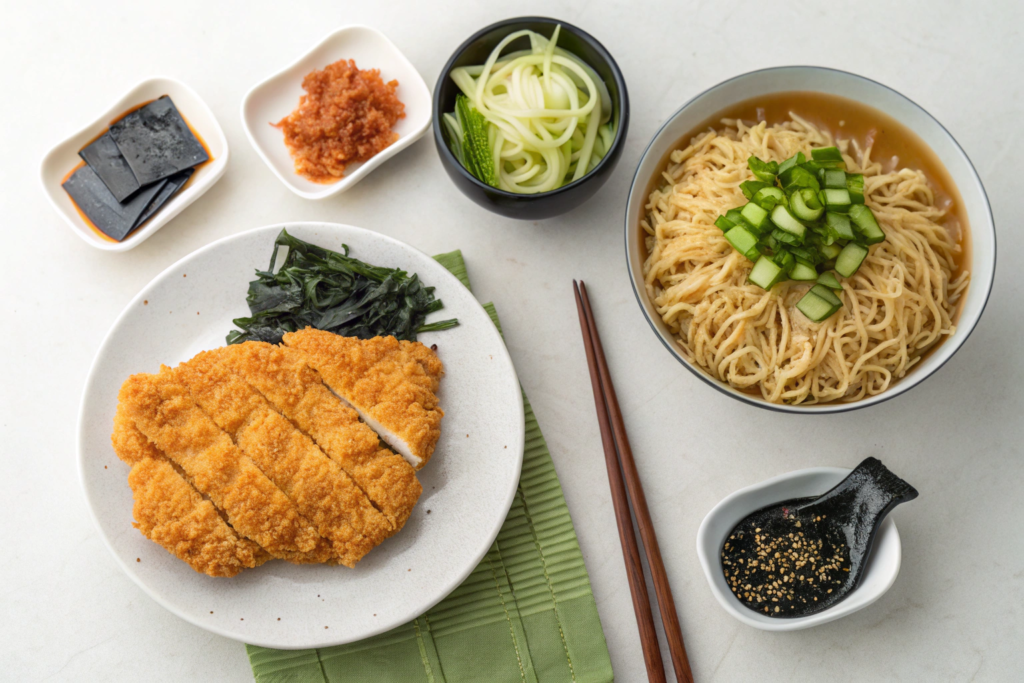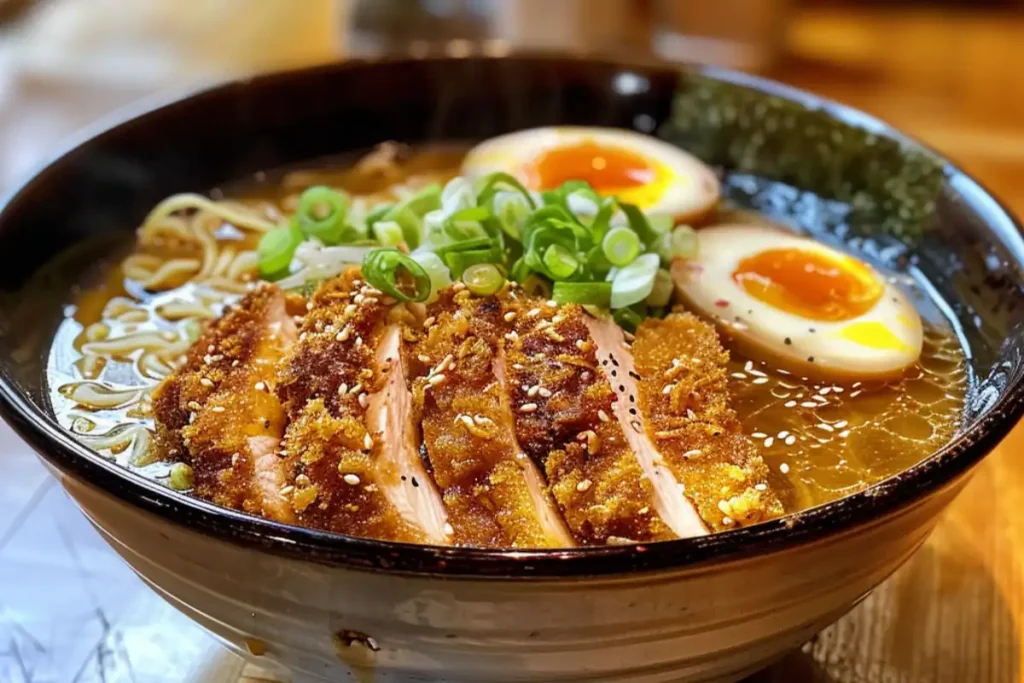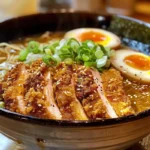Chicken Katsu Ramen is a delightful fusion dish that combines the best of two popular Japanese comfort foods: crispy chicken katsu and savory ramen. This dish is not only a feast for the taste buds but also a comfort meal that warms the soul. The contrast between the crunchy chicken and the silky ramen noodles, all drenched in a rich, flavorful broth, makes it an unforgettable culinary experience.
Table of Contents
Why Chicken Katsu Ramen is Unique
Chicken Katsu Ramen stands out for its perfect balance of textures and flavors. The crispy, breaded chicken katsu contrasts beautifully with the soft, tender ramen noodles, creating a satisfying eating experience. The savory, umami-rich broth enhances the flavor, whether it’s miso, shoyu, or tonkotsu-based. Additionally, this dish is highly versatile—you can adjust the spice level, swap the broth type, or even make a vegetarian version using plant-based alternatives. These qualities make Chicken Katsu Ramen a standout dish that appeals to a variety of tastes.
Essential Ingredients for Chicken Katsu Ramen

Making Chicken Katsu Ramen at home requires a few key ingredients that contribute to its rich flavor and texture.
1. Chicken Katsu
- Chicken Breast or Thighs: Thighs offer more juiciness, while breasts are leaner.
- Panko Breadcrumbs: These Japanese-style breadcrumbs create the signature crispy coating.
- Flour and Eggs: Help the breadcrumbs adhere to the chicken.
- Vegetable Oil: Used for frying to golden perfection.
2. Ramen Broth
- Broth Base (Miso, Shoyu, or Tonkotsu): Miso adds depth, shoyu is lighter, and tonkotsu is rich and creamy.
- Garlic and Ginger: Provide warmth and enhance the broth’s flavor.
- Soy Sauce and Mirin: Contribute umami and complexity.
- Dashi: A Japanese stock that enriches the broth.
3. Ramen Noodles and Toppings
- Ramen Noodles: Fresh noodles are chewier, while dried noodles are more convenient.
- Toppings: Common choices include green onions, nori (seaweed), boiled eggs, sesame seeds, and bamboo shoots for added flavor and texture.
If you enjoyed this recipe and are looking for other chicken dishes, you might also like the Marry Me Chicken Orzo, which combines tender chicken with a creamy, flavorful orzo pasta.
Step-by-Step Guide to Preparing Chicken Katsu
Ingredients for Chicken Katsu:
- Chicken Breasts or Thighs: 2 pieces, boneless and skinless
- Panko Breadcrumbs: 1 cup
- All-Purpose Flour: 1/2 cup
- Eggs: 2 large, beaten
- Salt: 1 teaspoon
- Black Pepper: 1/2 teaspoon
- Vegetable Oil: Enough for frying (about 1 cup or enough to fill the pan with 1/2 inch of oil)
for Ramen Broth:
- Miso Paste (or Shoyu, Tonkotsu Base): 3 tablespoons (for miso broth)
- Dashi Stock: 4 cups
- Soy Sauce: 2 tablespoons
- Mirin: 1 tablespoon
- Garlic: 2 cloves, minced
- Ginger: 1-inch piece, minced
- Sesame Oil: 1 tablespoon
- Water: 4 cups (or adjust based on desired broth consistency)
for Ramen Noodles and Toppings:
- Ramen Noodles: 4 servings (fresh or dried)
- Green Onions: 2 stalks, sliced thinly
- Nori (Seaweed): 2 sheets, cut into strips
- Soft-Boiled Eggs: 2 eggs, halved
- Sesame Seeds: 1 tablespoon
- Bamboo Shoots: 1/2 cup (optional)
- Chili Oil: To taste (optional)
- Sriracha: To taste (optional)
- Soy Sauce: To taste (for additional seasoning)
- Nori Sheets: Optional for garnish
Optional Ingredients:
- Sake: 1 tablespoon (optional, for added depth in the broth)
- Rice Vinegar: 1 teaspoon (optional, to balance the broth)
- Chili Paste: 1 teaspoon (for a spicy broth variation)
- Tofu: 1 block, sliced (for a vegetarian version of katsu)
Now that we’ve covered the ingredients, let’s dive into the preparation of chicken katsu, the star of the dish.

Preparing the Chicken Katsu
- Flatten & Season: Pound chicken to even thickness, then season with salt and pepper.
- Breading: Coat in flour, dip in egg, and press into panko.
- Frying: Fry for 3-4 minutes per side until golden brown.
Making the Ramen Broth
- Sauté Aromatics: Cook garlic and ginger in sesame oil.
- Add Broth Base: Stir in miso paste, soy sauce, or tonkotsu base.
- Simmer: Pour in dashi and water, then simmer for 20-30 minutes.
- Adjust Seasoning: Taste and add soy sauce or mirin if needed.
For those looking to explore the different types of ramen broth and their unique characteristics, check out this Guide to Ramen Broth
Cooking the Ramen Noodles
- Boil noodles according to package instructions.
- Drain and rinse under cold water.
Assembling the Dish
- Warm the Bowl: Fill with hot water, then discard before adding ingredients.
- Add Noodles & Broth: Place noodles in a bowl and pour hot broth over them.
- Arrange the Chicken: Slice and place katsu on top.
- Garnish: Add green onions, nori, sesame seeds, and a boiled egg.
For additional inspiration on side dishes that complement chicken dishes, you might explore the Best Sides to Serve with Chicken Piccata, which offers a variety of flavorful options.
Variations and Dietary Considerations
Chicken Katsu Ramen is a versatile dish that can be adapted to suit different tastes and dietary needs.
1. Popular Variations
- Spicy Miso Chicken Katsu Ramen: Add a spoonful of spicy miso paste to the broth for a kick of heat. You can also drizzle some chili oil on top for an extra layer of spiciness.
- Vegetarian Option: Replace the chicken katsu with tofu katsu, which is made by breading and frying thick slices of tofu. Use a vegetable-based broth instead of the traditional meat-based ones.
- Gluten-Free Version: Use gluten-free panko breadcrumbs and gluten-free ramen noodles. Ensure that the broth is also gluten-free by checking the ingredients of miso paste and soy sauce.
2. Dietary Modifications
- Lowering Sodium: To reduce the sodium content, opt for a low-sodium soy sauce and use less salt when seasoning the broth and chicken. Additionally, you can dilute the broth with water or unsalted dashi.
- Reducing Fat Content: For a lighter version, bake the chicken katsu instead of frying it. You can also skim off any excess fat from the broth before serving.
- Lactose-Free Option: Ensure that all ingredients, particularly the broth and katsu, are free from dairy. You can use lactose-free panko and replace any dairy in the broth with plant-based alternatives.
For those who enjoy exploring other comforting chicken dishes, you might also find the Quick and Easy Chicken Noodle Soup recipe insightful, as it provides a comprehensive guide to another classic comfort food.
Chicken Katsu Ramen is a must-try dish for anyone who loves the comforting flavors of ramen combined with the satisfying crunch of fried chicken. The balance of textures and flavors in this dish is truly unique, making it a standout among ramen varieties. Whether you’re making it at home or ordering it at your favorite restaurant, Chicken Katsu Ramen is sure to become a favorite in your culinary repertoire.
FAQs About Chicken Katsu Ramen
1. What is chicken katsu ramen?
- Chicken Katsu Ramen is a Japanese fusion dish that combines crispy breaded and fried chicken (katsu) with ramen noodles and a rich broth. It’s a hearty and flavorful meal that marries the crunch of katsu with the comforting warmth of ramen.
2. What type of broth is best for chicken katsu ramen?
- Miso or shoyu broth are commonly used, as they complement the flavors of the chicken katsu. Tonkotsu broth, although richer and heavier, is also a great option for those who prefer a more indulgent ramen experience.
3. Can chicken katsu ramen be made gluten-free?
- Yes, by using gluten-free breadcrumbs and ramen noodles, you can create a gluten-free version of Chicken Katsu Ramen. Ensure that the broth and other ingredients are also gluten-free.
4. How can I make a healthier version of chicken katsu ramen?
- Consider baking the chicken katsu instead of frying and using a broth with reduced sodium. You can also use lean cuts of chicken and skim off any excess fat from the broth.
5. What are some good side dishes to serve with chicken katsu ramen?
- Side dishes like gyoza, seaweed salad, or edamame are excellent accompaniments to Chicken Katsu Ramen. These sides complement the flavors and add variety to the meal.
Chicken Katsu Ramen
This Chicken Katsu Ramen combines crispy, golden-brown panko-breaded chicken with a rich, flavorful ramen broth. Topped with soft-boiled eggs, green onions, and sesame seeds, this dish is the ultimate comfort food with a Japanese twist! 🍜🔥🐔
- Prep Time: 15 minutes
- Cook Time: 30 minutes
- Total Time: 45 minutes
- Category: Lunch
- Method: Stovetop,Fried
- Cuisine: Japanese
Ingredients
For the Chicken Katsu:
- 2 boneless, skinless chicken breasts
- ½ cup all-purpose flour
- 1 tsp salt
- ½ tsp black pepper
- 2 large eggs, beaten
- 1 cup panko breadcrumbs
- ½ cup vegetable oil (for frying)
For the Ramen Broth:
- 1 tbsp sesame oil
- 3 cloves garlic, minced
- 1 tbsp fresh ginger, grated
- 3 tbsp miso paste (white or red)
- 2 tbsp soy sauce
- 1 tbsp mirin (optional)
- 4 cups chicken or vegetable broth
- 1 cup water
- 1 tsp chili paste (optional for spice)
For the Ramen Bowl:
- 4 packs ramen noodles (discard seasoning packets)
- 2 soft-boiled eggs, halved
- ½ cup green onions, sliced
- ½ cup shiitake mushrooms, sliced
- ¼ cup corn kernels (optional)
- 1 tbsp sesame seeds
- Nori sheets (for garnish)
Instructions
-
Prepare the Chicken Katsu:
- Place chicken breasts between plastic wrap and gently pound to ½-inch thickness.
- Season with salt and black pepper.
- Dredge each piece in flour, dip into beaten eggs, and coat with panko breadcrumbs.
- Heat vegetable oil in a skillet over medium heat.
- Fry chicken for 3-4 minutes per side until golden brown and crispy.
- Transfer to a plate lined with paper towels and slice into strips.
-
Make the Ramen Broth:
- In a large pot, heat sesame oil over medium heat.
- Sauté garlic and ginger for 1 minute until fragrant.
- Stir in miso paste, soy sauce, and mirin.
- Add chicken broth and water, then bring to a gentle simmer for 10 minutes.
-
Cook the Ramen & Toppings:
- Cook ramen noodles according to package instructions. Drain and set aside.
- Soft-boil eggs by simmering for 6-7 minutes, then transfer to an ice bath before peeling.
- Sauté shiitake mushrooms until tender.
-
Assemble the Ramen Bowls:
- Divide ramen noodles into bowls.
- Ladle hot broth over the noodles.
- Top with sliced chicken katsu, soft-boiled eggs, mushrooms, corn, and green onions.
- Sprinkle with sesame seeds and add nori sheets for garnish.
-
Serve & Enjoy:
- Serve immediately with extra soy sauce or chili paste on the side.
Notes
- For extra crispiness, double-coat the chicken in panko.
- For a spicy kick, add chili oil or Sriracha to the broth.
- For a lighter version, bake the chicken at 400°F (200°C) for 20 minutes instead of frying.



3 thoughts on “Chicken Katsu Ramen”